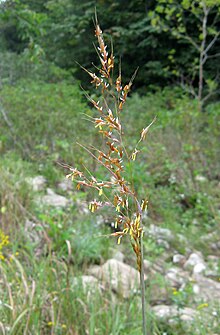Indian Grass
| Sorghastrum nutans | |
|---|---|
 |
|
| Indiangrass in bloom | |
| Scientific classification | |
| Kingdom: | Plantae |
| (unranked): | Angiosperms |
| (unranked): | Monocots |
| (unranked): | Commelinids |
| Order: | Poales |
| Family: | Poaceae |
| Genus: | Sorghastrum |
| Species: | S. nutans |
| Binomial name | |
|
Sorghastrum nutans (L.) Nash |
|
| Synonyms | |
|
|
Sorghastrum nutans, commonly known as either Indiangrass or yellow Indiangrass, is a North American prairie grass found in the central and eastern United States and Canada, especially in the Great Plains and tallgrass prairies.
Indiangrass is a warm-season perennial bunchgrass. It is intolerant to shade. It grows 3 to 7 feet (1 to 2 m) tall, and is distinguished by a "rifle-sight" ligule where the leaf blade attaches to the leaf sheath. The leaf is about 3 feet (1 m) long.
It blooms from late summer to early fall in Illinois, producing branched clusters (panicles) of spikelets. The spikelets are golden-brown during the blooming period, and each contain one perfect floret that has three large, showy yellow stamens and two feather-like stigmas. One of the two glumes at the base of the spikelets is covered in silky white hairs. The flowers are cross-pollinated by the wind.
The branches of pollinated flower clusters bend outwards. At maturity, the seeds fall to the ground. They weigh at about 175,000 seeds to the pound.
Leaves in June
"Rifle-sight" ligule at the base of a leaf
Flowers with yellow stamens and golden-brown spikelets
Closeup of seeds
Sorghastrum nutans is prominent in the tallgrass prairie ecosystem and the northern, central, and Flint Hills tall grassland ecoregions, along with big bluestem (Andropogon gerardi), little bluestem (Schizachyrium scoparium) and switchgrass (Panicum virgatum). It is also common in areas of longleaf pine.
...
Wikipedia
